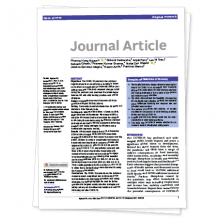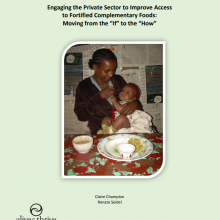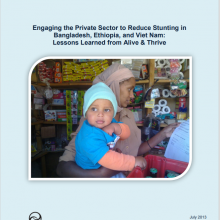Journal article
Jul 07 2015

Scaling up impact on nutrition: What will it take?
This paper included a literature review and four case studies (including A&T work in Bangladesh) on large-scale nutrition programs with proven impact.
Report
Feb 27 2015

Engaging the Private Sector to Improve Access to Fortified Complementary Foods: Moving from the “If” to the “How”
Examines private sector engagement in improving access to fortified complementary foods for children 6‒24 months of age.
Report
Dec 17 2014

Engaging the Private Sector to Reduce Stunting in Bangladesh, Ethiopia, and Viet Nam
Summarizes Alive & Thrive’s experience in engaging the private sector to increase supply, demand, and use of fortified complementary foods and products.
Journal article
Dec 13 2013

Handwashing before food preparation and child feeding: a missed opportunity for hygiene promotion (Nizame FA., 2013. American Journal of Tropical Medicine and Hygiene)
Enteric diseases are often caused by poor hygiene and can contribute to stunting. In Bangladesh preparing food, serving food, feeding children, and eating food with bare hands is a common practice, yet most handwashing promotion has focused on fecal contact.
Journal article
Oct 02 2013

Household food insecurity is associated with higher child undernutrition but the effect is not mediated by child dietary diversity (Ali D., 2013. Journal of Nutrition)
Household food insecurity (HFI) is a recognized underlying determinant of child undernutrition, but evidence of associations between HFI and child undernutrition is mixed.
Journal article
Sep 25 2013

A program impact pathway analysis identifies critical steps in the implementation and utilization of a behavior change communication intervention promoting infant and child feeding practices in Bangladesh (Avula R., 2013. Journal of Nutrition)
Mapping pathways of how interventions are implemented and utilized enables contextually grounded interpretation of results, differentiates poor design from poor implementation, and identifies factors that might influence the utilization of interventions.

